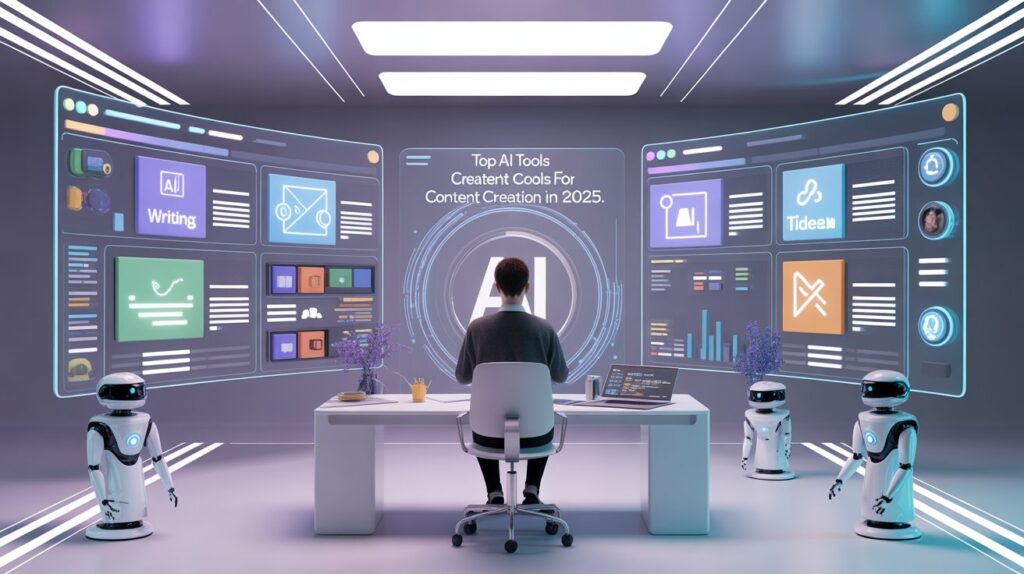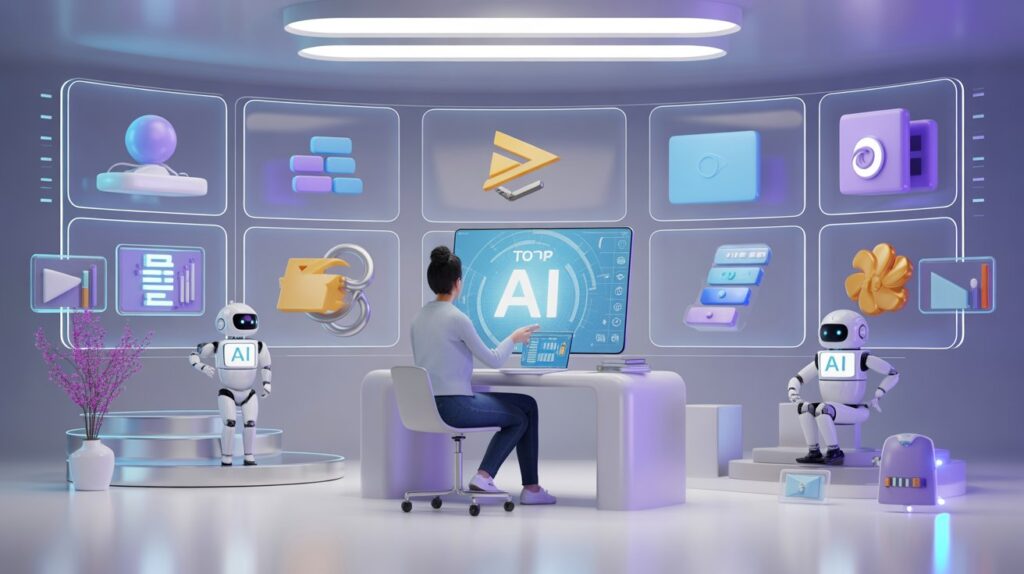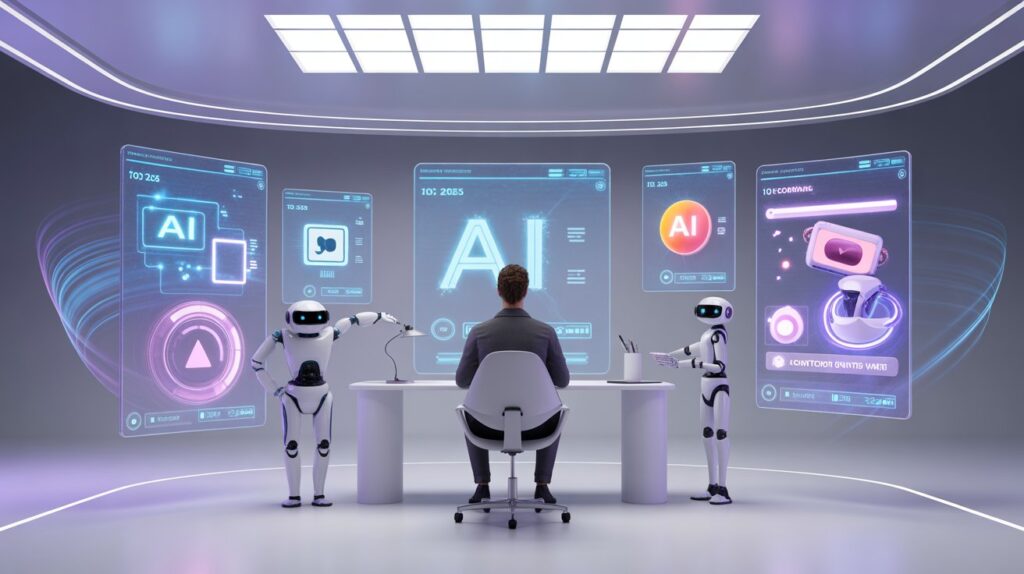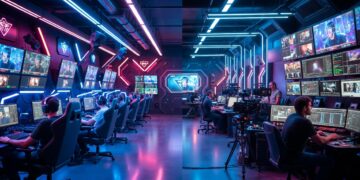Artificial Intelligence (AI) has rapidly transformed how we create, distribute, and optimize content. In just a few years, AI-powered tools have gone from assisting with grammar checks to generating complete marketing campaigns, videos, and designs. As we step into 2025, the competition among AI tools has intensified, giving content creators, marketers, and brands more power and flexibility than ever before.
Whether you’re a social media manager, a blogger, or a brand strategist, the right AI tools can help you streamline your workflow, boost creativity, and maintain consistent quality. This guide explores the Top AI Tools for Content Creation in 2025, detailing what makes each one stand out, how they fit into your content strategy, and the trends shaping the AI landscape this year.
Why AI Tools Matter More Than Ever in 2025
The digital content ecosystem is growing exponentially. According to recent industry insights, over 80% of marketers now use AI in some form to support their content strategy. The reasons are clear:
-
Efficiency: AI tools can generate ideas, outlines, and even polished drafts in minutes.
-
Scalability: They enable teams to produce more content without increasing headcount.
-
Optimization: AI analytics and SEO tools refine content to perform better across platforms.
-
Personalization: Modern AI systems can adapt tone, structure, and visuals to fit different audiences.
In 2025, content creation is not just about producing text or visuals—it’s about creating integrated, personalized, and data-driven experiences. Let’s explore the leading AI tools making that possible.
What to Look for in an AI Content Creation Tool
Before diving into the tools themselves, it’s important to understand what features separate the good from the great. The Top AI Tools for Content Creation in 2025 share several key characteristics:
1. Versatility Across Formats
AI tools should support multiple content types—text, image, video, and audio—allowing creators to manage all aspects of content production in one ecosystem.
2. Brand Consistency
The ability to train AI on brand tone and style ensures that content remains aligned with your identity across all channels.
3. SEO and Optimization Features
Incorporating keyword research, readability checks, and search intent optimization is essential for visibility in AI-driven search algorithms.
4. Collaboration and Workflow Integration
Modern teams rely on seamless collaboration. The best tools integrate with CMS platforms, design suites, and analytics dashboards.
5. Ethical AI Use
With growing scrutiny on AI-generated content, transparency, fact-checking, and data privacy are now crucial evaluation criteria.
Categories of AI Tools for Content Creation
A. AI Writing and Copy Generation
1. Jasper
Jasper remains a leader in AI writing for marketing, blogs, and ad copy. Its natural language generation capabilities are enhanced in 2025 with deeper integrations for brand voice and tone control. Jasper’s “Campaign Mode” can produce a full suite of marketing assets from one brief—perfect for agencies and teams managing multiple brands.
Best for: Marketing teams, agencies, content strategists
Standout feature: Brand voice training and long-form campaign generation
2. Copy.ai
Copy.ai continues to evolve as a powerful short-form content generator. Its latest update includes AI-assisted brainstorming and content idea mapping, helping creators overcome writer’s block quickly.
Best for: Social media managers, small businesses
Standout feature: Fast and engaging short-form copy creation
3. Writesonic
Known for its balance of affordability and functionality, Writesonic in 2025 offers SEO-optimized long-form content powered by GPT-5. It now includes a real-time plagiarism checker and SERP analyzer to help ensure originality and ranking potential.
Best for: Bloggers and SEO content writers
Standout feature: Built-in SEO optimization and plagiarism protection
B. AI Tools for Visual and Image Creation
4. Midjourney
Midjourney continues to dominate AI-driven design. Its 2025 version adds a browser-based interface and supports “style memory,” allowing creators to maintain visual consistency across campaigns.
Best for: Designers, digital marketers, brand creators
Standout feature: High-fidelity design generation and stylistic consistency
5. Canva Magic Studio
Canva’s Magic Studio has revolutionized content design for non-designers. It integrates AI tools for image generation, layout optimization, and automated resizing for social platforms.
Best for: Social media creators, entrepreneurs
Standout feature: User-friendly interface with cross-platform design automation
6. Adobe Firefly
Adobe’s Firefly suite offers professional-grade image, video, and text effects using generative AI. Its integration with Adobe Creative Cloud makes it ideal for creators who need precision and control.
Best for: Professional designers and video editors
Standout feature: Seamless Adobe ecosystem integration
C. AI Video and Audio Creation Tools
7. Synthesia
Synthesia has become a staple for video content creation. In 2025, it allows users to generate multilingual AI videos with lifelike avatars and synchronized voiceovers in over 120 languages.
Best for: Corporate training, marketing videos, e-learning
Standout feature: Realistic AI avatars and multilingual support
8. Descript
Descript merges audio and video editing into one platform. Its “Overdub” feature allows creators to generate new voice content by typing, while the 2025 update adds automatic filler removal and emotion control.
Best for: Podcasters, YouTubers, content editors
Standout feature: Text-based audio/video editing with voice cloning
D. AI Tools for SEO and Optimization
9. Surfer SEO
Surfer SEO’s latest upgrade leverages AI insights to recommend not just keywords but full structural improvements for ranking in AI-based search engines. It integrates directly with Jasper and Writesonic for seamless optimization.
Best for: SEO professionals and content strategists
Standout feature: Data-driven content scoring and competitor gap analysis
10. NeuronWriter
NeuronWriter blends AI writing with SEO analysis. Its real-time recommendations help align content with user intent, making it one of the most efficient optimization tools available in 2025.
Best for: Bloggers, agencies
Standout feature: NLP-based optimization and keyword clustering
E. Workflow and Content Repurposing Tools
11. OpusClip
A rising star in 2025, OpusClip transforms long videos into short, social-ready clips automatically, identifying the most engaging segments and adding captions.
Best for: Social media marketers, influencers
Standout feature: AI-driven video repurposing
12. Notion AI
Notion AI extends beyond note-taking—it now manages content workflows, summarizes research, and generates ideas. Its integration with publishing tools makes it a hub for team collaboration.
Best for: Writers, teams, content planners
Standout feature: AI-powered project management and idea generation
How to Choose the Right AI Tool for Your Needs
The right AI tool depends on your content goals, team structure, and workflow. Here’s how to make an informed choice:
-
Define your content goals: Are you focused on blogs, social media, or video production?
-
Assess your skill level: Choose tools that match your technical proficiency.
-
Consider integration: Tools that connect with CMS platforms and CRMs save time.
-
Budget smartly: Many tools offer free tiers—experiment before committing.
-
Ensure compliance: Check data privacy and licensing terms for AI-generated assets.
How to Integrate AI into Your Content Workflow
To maximize the benefits of these tools, think in terms of process, not just production.
-
Research and Ideation: Use AI to identify trending topics and audience interests.
-
Drafting and Creation: Employ writing or video AI tools to produce initial drafts quickly.
-
Editing and Branding: Human editors refine tone, check facts, and align messaging.
-
Optimization: Use SEO tools like Surfer SEO or NeuronWriter to refine content.
-
Publishing and Repurposing: Deploy repurposing tools like OpusClip or Canva Magic Studio for multi-platform reach.
-
Performance Review: Leverage analytics integrations to measure engagement and ROI.
Emerging Trends in AI Content Creation for 2025
As AI continues to evolve, several new trends are shaping content creation in 2025:
-
Agentic AI Workflows: AI assistants that handle entire content cycles autonomously.
-
Multimodal Content Generation: Tools that merge text, image, and video creation seamlessly.
-
Localized Content Personalization: Increased focus on language and cultural adaptation.
-
Ethical and Authentic AI: Tools now prioritize transparency, originality, and responsible use.
-
AI Search Optimization: As AI-driven search engines rise, optimization is shifting from keywords to semantic intent and structured data.
Staying ahead of these trends will help you maintain a competitive edge.
FAQs About AI Content Creation
Q1: Can AI tools replace human creators?
No. AI tools are designed to assist, not replace. Human creativity, judgment, and emotional intelligence remain essential for storytelling and strategy.
Q2: Are AI-generated contents penalized by search engines?
Not if used correctly. Search engines reward value, accuracy, and originality. AI tools should be used to enhance—not automate—content quality.
Q3: Which AI tool is best for beginners?
Canva Magic Studio and Copy.ai are user-friendly and ideal for creators starting their AI journey.
Q4: Are these tools suitable for all industries?
Yes, though customization matters. Marketing, e-learning, real estate, healthcare, and e-commerce all benefit from AI tools tailored to their content needs.
Q5: How can I ensure my AI content aligns with brand voice?
Choose tools that allow brand training (like Jasper) or manually review and adjust tone before publishing.
Conclusion
AI is no longer a futuristic concept—it’s the backbone of modern content creation. The Top AI Tools for Content Creation in 2025 empower creators to produce high-quality, engaging, and optimized content faster than ever before. However, the key to success lies in balance: leveraging AI’s efficiency while maintaining a distinctly human touch.
Whether you’re a solo creator or managing a large team, adopting the right mix of writing, visual, video, and SEO tools will transform your workflow, enhance productivity, and future-proof your content strategy. The future of creation is collaborative—and AI is your most powerful partner in that journey.












